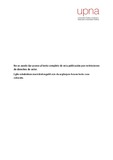Mostrar el registro sencillo del ítem
More integrated than ever? Long-term market and policy drivers of intra-Asian trade
| dc.creator | Ayuso Díaz, Alejandro | es_ES |
| dc.creator | Gómez Gómez-Plana, Antonio | es_ES |
| dc.date.accessioned | 2024-01-31T16:15:33Z | |
| dc.date.available | 2024-01-31T16:15:33Z | |
| dc.date.issued | 2023 | |
| dc.identifier.citation | Gómez Gómez-Plana, A., Ayuso-Díaz, A. (2023) More integrated than ever? Long-term market and policy drivers of intra-Asian trade. Journal of Economic Integration, 38(1), 32-58. https://doi.org/10.11130/jei.2023.38.1.32. | es_ES |
| dc.identifier.issn | 1225-651X | es_ES |
| dc.identifier.uri | https://hdl.handle.net/2454/47283 | |
| dc.description | Alojado según Res. CNEAI 5/12/23 (ANECA) | es_ES |
| dc.description.abstract | Since the Doha Round stalemate after 2001, trade liberalization has progressed through regional trade agreements (RTAs) and East and Southeast Asia is not unfamiliar with this. Before assessing the effectiveness of recent trade agreements, the long tradition of trade exchange in this region that has lasted for more than 2,000 years necessitates an understanding of the evolution of intra-Asian trade across history. In this regard, this study contributes to the literature examining whether present intra-Asian trade is more or less intense than before 1938. This research outperforms previous studies using a gravity model that controls for changes in GDP and trade costs in the region across four different time periods (between 1840 and 2018). The results show that contemporary regional trade in East and Southeast Asia is slightly less intense than before World War II. A second question addressed is the relevance of trade agreements after the 1985 Plaza Accord on trade integration, compared with market determinants. A second gravity model for regional imports after 1986 is regressed on both policy and market indicators, indicating that the latest wave of intra-Asian trade is characterized by trade complementarities that are fueled by regional foreign direct investment, and free trade agreements are less effective. This result is validated through a network analysis demonstrating the symbiosis between trade and investment flows in the region, which should be considered in RTAs that are in place or in negotiation to take intra-Asian trade beyond its historical limits. | es_ES |
| dc.format.mimetype | application/pdf | en |
| dc.language.iso | eng | en |
| dc.publisher | Institute for International Economics, Sejong University | en |
| dc.relation.ispartof | Journal of Economic Integration, 38(1), 32-58. | en |
| dc.rights | *** | es_ES |
| dc.subject | Regional integration | en |
| dc.subject | Gravity model | en |
| dc.subject | Foreign direct investment | en |
| dc.subject | Free trade areas | en |
| dc.subject | Network analysis | en |
| dc.title | More integrated than ever? Long-term market and policy drivers of intra-Asian trade | en |
| dc.type | Artículo / Artikulua | es |
| dc.type | info:eu-repo/semantics/article | en |
| dc.date.updated | 2024-01-31T13:43:53Z | |
| dc.contributor.department | Economía | es_ES |
| dc.contributor.department | Ekonomia | eu |
| dc.contributor.department | Institute for Advanced Research in Business and Economics - INARBE | en |
| dc.rights.accessRights | Acceso cerrado / Sarbide itxia | es |
| dc.rights.accessRights | info:eu-repo/semantics/closedAccess | en |
| dc.identifier.doi | 10.11130/jei.2023.38.1.32 | es_ES |
| dc.relation.publisherversion | https://doi.org/10.11130/jei.2023.38.1.32 | es_ES |


